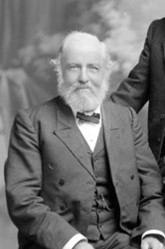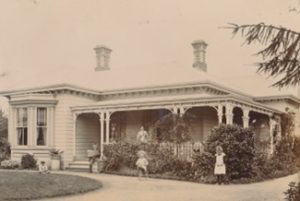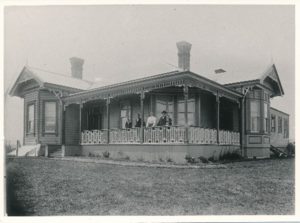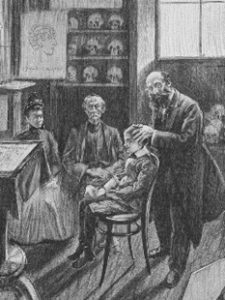Cambridge – The best place to live
-
Doctor Roberts of Devonport[1] … said I required a more bracing air than the North Shore and as I had lived so many years by the seaside, he recommended I should go inland to Cambridge in the Waikato as the best place.
William Rout, 1893
William Rout (pictured) was an affluent businessman from Nelson. He founded a land, estate and commission agency in 1862, and held office as a member of the Nelson Provincial Council 1873-76 and Provincial Treasurer 1874-75.

After retiring in 1887, William and first wife Harriet decided to return to England. Harriet died at sea, leaving William and their three grown up sons and four daughters.
William suffered from poor health, and when he was advised by his doctor in 1893 to retire to Cambridge, he immediately took his new wife Annie, their young son Nelson and baby Wilhelmina to visit the town “to see how we should like the place.”
He stepped into a community undergoing significant transformation. The recent New Zealand Wars and the confiscation of Māori lands had left a lasting impact on the farming landscape. The Native Land Courts and the prosperity they had generated for local businesses had come and gone. Although the introduction of a railway link was welcomed, the town was still isolated compared to bustling Hamilton.
We stayed at Cambridge a week which is a pretty little borough of about 700 inhabitants. The town has the appearance of once doing a large business with three large hotels and a very large livery stables and other appurtenances. The whole place looks like a deserted village and the inhabitants look dispirited awaiting better times.
William Rout, 1893
The family moved in to a rented home in Alpha Street at first. Then they purchased a home on the corner of Alpha and Chapel Streets, which was eventually sold to the Catholic Church.
William Rout kept a detailed journal up until his death in 1909. It is available at the National Library. We have used his written experiences and quotations throughout this article.

Rout Homestead in Alpha Street
Whare-ora – the House of Health
[The death of baby Wilhelmina from meningitis in 1895] was a severe blow to the wife, who has a most affectionate nature, so we invited various friends to visit to take off her thoughts from her bereavement. Amongst them we had Mr Arthur Wilkinson for a change of air.
William Rout, 1895

A new form of treatment for Tuberculosis (TB) was emerging. Before the discovery of antibiotics, doctors believed that a regimen consisting of exposure to the open air at high altitudes, a cold climate, hygiene education and isolation was the most effective treatment.
The Lauriston Park homestead (pictured), named Whare-ora, was built by the Routs as a sanatorium. Annie Rout delighted in nursing and was keen to provide TB sufferers with a place to stay in Cambridge. A steady stream of visitors, both friends and patients, stayed at Whare-ora with the family throughout their time here.
Sanatoria were a hybrid between a hospital and a resort, built to maximise patients’ exposure to sunlight and clean air. The elevation of the Whare-ora property was well suited for a sanatorium.
The Box in the Barn
[We] accepted Hogan’s tender for the new house @ £842 and then began moving some of our goods, storing them in the new Barn and Rooms, leaving only the furniture of two bedrooms & my study in the house and the contents of the coachhouse and workshop outside until we leave for good.
William Rout, 1900
Before Whare-ora was built, a new barn and rooms were erected on the property. In 1900, the Rout family began moving some of their goods, storing them in the barn and rooms until the new house was ready.
In 2007, a box of archives was found in the old barn, and was donated to the Cambridge Museum. Many of the archives found there were given context by Rout’s meticulous journal entries.

CM3161/23: Whare-ora showing barn on the left.
The Museum is currently working on an exhibition containing some of the archives found in the box in the barn to be displayed in the main hall of the Lauriston Park Retirement Village.
Contributions to Cambridge
My benevolence is active and constantly urging me to help others as far as practicable to help themselves and to run alone.
William Rout, 1894
William Rout soon made himself known. He set up a Harmonic Society, Theosophical Society and Liberal Party Committee. He was Chairman of the Public Library, developed an archive for the Cambridge Museum and wrote the first History of Cambridge, later published in the Waikato Argus.
“At the quarterly meeting of St Andrew’s vestry, much satisfaction was expressed at the efforts being made under Mr Rout’s action and able conductorship to render a portion of the oratorio of the “Messiah” during the Christmas season, and the thanks of the Vestry were expressed to Mr Rout and all who are assisting him.”
Waikato Argus, 10 October 1896
He proposed that the Public School Committee set up a technical classroom. It enabled pupils to compete in the Young People’s Industrial Exhibition in 1897. As a result, four of the boys completed for judging: a cabinet of four drawers enclosed with an outer door, an upholstered music stool, a wheelbarrow and a footstool. William Rout had once been a builder in Nelson and so he, along with local tradesmen, taught in the classroom.
He had his fair share of disappointments. A large shipment of uninsured oratorio music for which he had paid was lost in a shipwreck, the Harmonic Society soon folded, and he was appalled to learn that his trusted Librarian had stolen a large sum of money from library funds.
He banned Reginald Bernard Fitzpatrick from the library because of “obstreperous behaviour”. Fitzpatrick became so abusive to him personally, including publicly criticising his published “History of Cambridge”, that Rout took him to court. Soon afterwards, Fitzpatrick began abusing his own lawyer Frank Buckland. (This is not the first time I have written about Fitzpatrick. He was also taken to court by Mrs Murphy. Read about it in our August 2021 newsletter on our website – click on “Join In”, then “Newsletters”.)
Peculiar in our views
It appears from what comes to our ears that we have a reputation for kindness and hospitality but are thought to be peculiar in our views.
William Rout, 1905
 Soon after their arrival, William and Annie consulted together about attending church in Cambridge “to prevent any further ostracising of the family by professing Christians” and decided on the Presbyterian Church. In his journal, William wrote scathingly about church services.
Soon after their arrival, William and Annie consulted together about attending church in Cambridge “to prevent any further ostracising of the family by professing Christians” and decided on the Presbyterian Church. In his journal, William wrote scathingly about church services.
A religious freethinker, he preferred to study Theosophy[2]. He also dabbled in Phrenology, Spiritualism and the Zodiac.
Phrenology is measuring the bumps on people’s heads to read their characters. By the 1890s, phrenology had been largely discredited as a pseudoscience although it remained popular for many years. William Rout often provided free readings for friends and acquaintances.
William died in 1909 at the age of 79. At the top of his gravestone in Pukerimu Cemetery are symbols surrounded by a snake devouring its tail – icons of the Theosophical Society – thus reflecting the true depth of his interest.
The Phrenologist, by A Hatrick 1895
[1] Incidentally, Dr Roberts of Devonport, who advised Rout to move to Cambridge, ended up following his own advice. He moved to Cambridge in 1890 “for reasons of health” and stayed until his death in 1917. Ref: The Cyclopedia of New Zealand
[2] Theosophy: a system that embraces a central truth underlying religion, philosophy and science.
William Rout’s photograph: Rout. Nelson Provincial Museum, Tyree Studio Collection: 76365. Cropped from
original image with permission.
References: Cambridge Museum files and archives, Lyn Williams “The Dead Tell Tales” published in the Waikato Times 27/11/2015, and paperspast.natlib.govt.nz.
Prepared by Karen Payne for the Cambridge Historical Newsletter for October 2024
